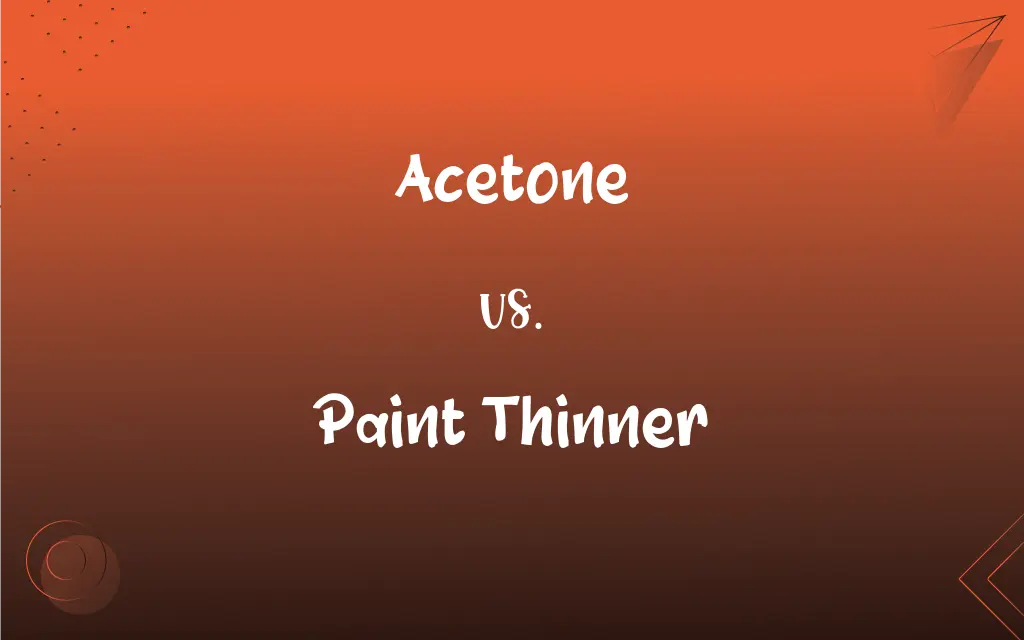Acetone vs. Paint Thinner: What's the Difference?
Edited by Aimie Carlson || By Harlon Moss || Published on January 8, 2024
Acetone is a volatile, colorless solvent used in many industries. Paint Thinner is a solvent mixture used to thin or remove paint.

Key Differences
Acetone is a colorless, highly volatile liquid with a distinct smell, primarily used as a solvent in various applications, including nail polish removal. Paint thinner, a broader category, refers to a range of solvents used to thin oil-based paints or clean painting equipment.
Chemically, acetone is a simple ketone and is known for its effectiveness in dissolving plastics, synthetic fibers, and other polymers. Paint thinners can be composed of various chemicals like mineral spirits, turpentine, or even acetone, depending on the formulation.
Acetone evaporates quickly and is often used in laboratory settings for its fast-drying properties. In contrast, paint thinners may have slower evaporation rates, making them suitable for thinning paint without rapid drying.
The use of acetone is not limited to the industrial sector; it's also common in household products for cleaning purposes. Paint thinner, while also used for cleaning, is primarily associated with the painting industry for adjusting paint consistency and cleaning brushes.
Acetone is typically more potent and aggressive as a solvent compared to many paint thinners. However, paint thinners are specifically formulated to be effective with certain types of paint, offering more specialized applications.
ADVERTISEMENT
Comparison Chart
Chemical Nature
Simple ketone
Various chemicals (mineral spirits, turpentine, etc.)
Primary Use
Solvent in industry and household
Thinning and removing oil-based paints
Evaporation Rate
Fast
Varies, generally slower
Solvent Strength
Potent and aggressive
Tailored to paint types
Common Applications
Nail polish remover, cleaning plastics
Adjusting paint consistency, cleaning brushes
ADVERTISEMENT
Acetone and Paint Thinner Definitions
Acetone
A volatile, colorless solvent.
Acetone is used to remove nail polish.
Paint Thinner
Cleaner for painting tools.
Brushes soaked in paint thinner can be easily cleaned.
Acetone
A simple ketone compound.
Acetone is produced naturally in human bodies.
Paint Thinner
Contains various chemical solvents.
Paint thinner may include mineral spirits.
Acetone
Common ingredient in cleaning products.
Acetone efficiently cleans grease stains.
Paint Thinner
Used in the painting industry.
Professionals use paint thinner for paint application.
Acetone
Fast-evaporating liquid.
Acetone is used in laboratories for quick drying.
Paint Thinner
Slower evaporating than other solvents.
Paint thinner allows for smoother paint application.
Acetone
Solvent for plastics and synthetic fibers.
Acetone can dissolve certain plastics.
Paint Thinner
Solvent mixture for thinning paint.
Paint thinner is used to adjust the viscosity of oil-based paint.
Acetone
A colorless, volatile, extremely flammable liquid ketone, C3H6O, widely used as an organic solvent. It is one of the ketone bodies that accumulate in the blood and urine when fat is being metabolized.
Acetone
(organic compound) A colourless, volatile, flammable liquid ketone, (CH3)2CO, used as a solvent.
Acetone
A volatile liquid consisting of three parts of carbon, six of hydrogen, and one of oxygen; pyroacetic spirit, - obtained by the distillation of certain acetates, or by the destructive distillation of citric acid, starch, sugar, or gum, with quicklime.
Acetone
The simplest ketone; a highly inflammable liquid widely used as an organic solvent and as material for making plastics
FAQs
Are acetone and paint thinner interchangeable?
Not always, as they serve different purposes and have different strengths.
What is acetone?
Acetone is a colorless, volatile solvent commonly used in industry.
Is acetone flammable?
Yes, acetone is highly flammable.
What is paint thinner?
Paint thinner is a solvent mixture for thinning oil-based paints.
Is acetone safe for removing paint?
It can remove some paints but is not ideal for all types.
Can paint thinner contain acetone?
Some paint thinners may include acetone in their formulation.
Is acetone more potent than paint thinner?
Generally, yes, acetone is a more aggressive solvent.
Is acetone environmentally friendly?
It can be harmful if not disposed of properly.
What precautions are needed when using acetone?
Use in a well-ventilated area and avoid open flames.
What are the primary uses of acetone?
Nail polish removal, cleaning plastics, and as a laboratory solvent.
Can paint thinner be used on all types of paint?
It's best for oil-based paints and not suitable for all types.
How should paint thinner be disposed of?
As a hazardous waste, following local regulations.
Is paint thinner safe for household use?
It should be used with caution and proper ventilation.
Can paint thinner damage surfaces?
Yes, it can harm certain surfaces if not used correctly.
What is the main ingredient in paint thinner?
Varies, but commonly mineral spirits or turpentine.
In what industries is paint thinner commonly used?
Mainly in the painting and decorating industry.
Are there eco-friendly alternatives to paint thinner?
Yes, there are less toxic and more environmentally friendly options available.
Can acetone dissolve plastics?
Yes, it can dissolve certain types of plastics.
Is acetone found in everyday products?
Yes, in nail polish removers and some cleaning agents.
Can acetone be used on skin?
It can be used, but excessive use can be harsh on skin.
About Author
Written by
Harlon MossHarlon is a seasoned quality moderator and accomplished content writer for Difference Wiki. An alumnus of the prestigious University of California, he earned his degree in Computer Science. Leveraging his academic background, Harlon brings a meticulous and informed perspective to his work, ensuring content accuracy and excellence.
Edited by
Aimie CarlsonAimie Carlson, holding a master's degree in English literature, is a fervent English language enthusiast. She lends her writing talents to Difference Wiki, a prominent website that specializes in comparisons, offering readers insightful analyses that both captivate and inform.






































































